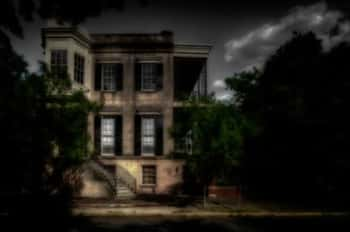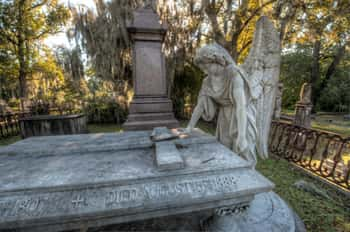If you eavesdrop on a tour happening in Savannah’s Wright Square, also known as “The Hanging Square,” the chances are high that you will be catching some part of the Alice Riley story. Alice Riley was the first woman hanged in Georgia for committing the first murder in the colony. Many tours talk about her romantic love with Richard White and how difficult their lives were as indentured servants to a cruel and callous man. That they had no choice but to murder this man so that they could run away together and begin anew. You may hear that they were captured and White was hanged immediately, but it was discovered later that Riley was pregnant, so she was executed months later after her baby was born.
If you’re lucky enough to hop on a ghost tour, you will hear the infamous Ghost Story of Alice Riley, and the tale of how she was pregnant at the time of her hanging and now her ghost follows pregnant women and mothers with infants, trying desperately to take their babies from them. Or that she was a witch who cursed all of Savannah’s citizens, and it’s because of this hex the Spanish Moss doesn’t grow on one side of the Live Oak Trees in Wright Square. Some stories say her body was left hanging as it took 3 days for her to die, then one night she mysteriously disappeared from the noose.
The legend of Alice Riley has grown into what some would call a “tall tale.” Such a shame. We all know that the truth is much more interesting than fiction. And as we uncover what little there is documented about Alice Riley, we find that in her short time in Georgia, her truth is just as fascinating as the some of the spinning you hear tour guides deliver on their stops in Wright Square.
A fresh start. More opportunity. A better life. Find a new beginning in a New World. One can imagine that those words have been bouncing inside people’s minds and rolling off their tongues for centuries as they dreamt of arriving in America with a bright future waiting to be had. Alice Riley was no different, even though her future in the new and exciting place was one that was purchased without any promises of freedom or opportunity.
Alice Riley and her “common law” husband, Richard White, arrived on the shores of Georgia in the fall of 1733. They had endured the turbulent voyage from Ireland with 38 other Irish servants. Many of them were nearly dead from starvation when the boat docked. But their faith in something better carried them through the misery and deplorable conditions, whilst their Irish will kept the hungry reaper of death from knocking down their door. Little did they know their boat ride was merely a preview of what their new life would entail in the new colony.M
On March 1, 1734, William Wise, an unpopular cattle farmer who had arrived in Savannah just a few months prior, was found dead in his house on Hutchinson Island. His head was in a large pail of water with his neckerchief tied around his neck. Wise’s alleged murder was the first murder reported in the new colony.
Wise had a reputation of being untrustworthy and sketchy. It was previously discovered that the young woman he had been referring to as his daughter was actually a prostitute. His bad behavior and unimpressive character influenced the Georgia Trustees to declined him a place on the charity list, but Wise took it upon himself to find a way to sail to Savannah. Upon arriving, James Oglethorpe, founder of Georgia, decided to send him across the water to work the cattle farm, instead of punishing England and shipping him back.
Alice Riley and Richard White were “assigned” to Wise as his indentured servants on the cattle farm. According to the letter written to General James Oglethorpe by Thomas Christie, the town recorder, Wise’s health was deteriorating, and he had been confined to his bed. Alice and Richard were tasked with caring for Wise’s hygiene, and presumably, it was no small task. Richard would comb Wise’s long hair, and Alice would bathe him. Some stories claim that it was Wise’s lewd comments and lascivious actions towards Alice that quickly made the daily routine unbearable.
Alice and Richard had reached the end of their tether and decided that they were no longer going to be Wise’s hygienical professionals. They chose to end Wise’s life and make a run for it, and it’s believed they took a few souvenirs with them, some of his personal property.
It is speculated that once Wise’s body was rendered lifeless, Alice and Richard fled the farmhouse. They hid out on the Island of Hope until eventually they were found, captured, and sentenced to death for the murder of William Wise.
In the book, General Oglethorpe’s Georgia 1733-1737, one can read hundreds of letters written to James Oglethorpe by his cohorts in Georgia while he was in England. And with a little patience and curiosity, one can uncover the truth of what exactly happened to Alice Riley and Richard White after their capture and sentencing.
In Christie’s letter dated December 14, 1734, he wrote that Wise was murdered and his personal effects were stolen and sold, presumed by the murderer. He details the scene of the crime, Alice Riley, under “the direction and influence of White,” set a pail of water down by Wise’s bed while White began to pretend to “assist and comb his hair.” White then grabbed the neckerchief and “twisted ‘till he was almost suffocated.”
Alice Riley at the same time took hold of the poll of his head and plunged his face in the pail of water and, he being very weak, it soon dispatched him. As to the rest I refer to the proceedings of the Court.
A month later, Edward Jenkins, an early settler of Savannah, wrote a letter to Oglethorpe clarifying the capture of Richard White and the accounts of Alice’s hanging. White had escaped jail after his original arrest and was subsequently captured again by brothers Henry and William Parker.
Jenkins wrote:
As we was working one of my men said, ‘Yonder goes a man very fast.’ I looked and saw the man and said, ‘I believe it’s White that broke out of prison. If it is him let us go and take him.’ So we pursued him ‘till we came into about twenty yards of him. At first sight of us [he] was much surprised. I told him, ‘Your name is White, it’s in vain to attempt [to escape].’ And immediately I seized him, he fell on his knees and, with many blows on his breast, begged his life.
Jenkins continues to outline the dramatic events of Richard’s fateful afternoon. He wrote that while leading White back into town, White “begged his life.” He was taken immediately to the gallows and declared to the last moment that he was not guilty of the murder.
Jenkins ended his letter regarding Alice Riley:
The woman was hanged yesterday, and denied the murder of Wise, and the most that she to answer for was her being so wicked to confess a thing she was not guilty of, by which means she imagined was the death of White. She seemed to be of the same principle as White was.
The last letter that references Alice Riley’s fateful new beginnings in Oglethorpe’s Georgia was written once again by Thomas Christie and addressed to The Trustees. On March 19, 1735, a year after William Wise’s body had been found, Christie’s last paragraph of his letter feels almost like an afterthought,
Alice Riley has hanged some months ago, within six weeks after her being brought to bed pursuant to her sentence of the 11th day of May last and the child is since dead.
Not a great deal of sympathy in any of these letters, or any doubts of her guilt.
Does anyone think that their personal story is going to be retold centuries later? Or that their life’s tale will be woven for historical entertainment or into an eerie ghost story for visitors to take home with them like a souvenir from their family vacation? Surely Alice Riley had no idea that her name would continue to be spoken and her short life in the Colony remembered well into the 21st Century. Alice Riley has become synonymous with Wright Square and one of all historians’ favorite Savannah characters.
Winston Churchill said, “History will be kind to me for I intend to write it.” We all seem to take those liberties, especially with our own history. But as we have discovered in the case of Alice Riley, the truth is much more intriguing than fiction. The not knowing, the mystery, and speculations, are all savory ingredients to a delicious tale. So, if you see the ghost of Alice Riley roaming Wright Square after dark, ask her if she did it! And remind her that there is dignity in history.
Two of our tours which visit Wright Square and tell the story of Alice Riley are the Grave Tales Tour and the Dead of Night Tour. If you're hoping to visit the locations in which this story took place, get your tickets at least a few days out, as these tours tend to sell out quickly!

Savannah's oldest and most haunted Cemetery

Savannah's most infamous haunted house

A quiet, and haunted Cemetery in Savannah